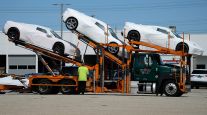Fleets Must Use Slump’s Lessons to Overcome Future Challenges
This story appears in the Oct. 24 print edition of Transport Topics.
GRAPEVINE, Texas — Fleets should prepare to bring the same zest to future challenges that they have used to overcome the struggling economy, fuel prices and government regulations in recent years, four industry leaders said.
“We have worked really hard and have made a lot of decisions that are good for the American public,” said Steve Williams, CEO of Maverick USA, speaking Oct. 18 at American Trucking Associations’ Management Conference & Exhibition here. “We must continue to be champions for the industry, for the environment and for safety.”
Williams, joined by Reggie Dupré, CEO of Dupré Logistics LLC; Douglas Stotlar, CEO of Con-way Inc.; and Gary Salisbury, CEO of Fikes Truck Line, outlined an agenda that builds on skills that were honed during the recession.
“We are focusing on margin improvement,” Stotlar said. “If we don’t improve our margins, we will be extinct. Trucking used to be a nickels and dimes business. Now it is about fractions of a cent.”
Salisbury, whose 350 tractors are run by owner-operators, focused on the changing role of independent contractors.
“We realize that to create a platform of sustainability in our company that we are going to have to do things differently,” he said. “A lot of [owner-operators] struggled and learned new ways of doing business. That is going to be the way [trucking] can actually move into the future.”
Dupré said, “We are coming out of a climate of abundant resources — capital, drivers and maintenance technicians.”
“Our industry is facing a future of scarce resources,” Dupré said, particularly drivers and capital, as well as new leaders and managers. “How we deploy those scarce resources is a shaping event.”
The panel was hosted by Transport Topics Publishing Group’s editorial director, Howard Abramson, and sponsored by Freightliner Trucks and Cummins Inc.
The four executives shared more than a focus on change, outlining a mixed business environment.
“2011 hasn’t been all we hoped it would be, but it is much better than the last couple of years,” said Williams, adding that business has been buoyed by constraints in capacity.
Analysts have estimated the overall truckload fleet has been culled by 12% to 15% in the past five years and now is pretty close to matching freight demand.
“There seems to be equilibrium in truckload and less-than-truckload,” Stotlar said, speaking of supply and demand. “The economy seems to be going sideways. If you put your emphasis in the right place, you can create your own traction.”
Dupré said demand is increasing for shipments to support energy exploration and petrochemicals, but gasoline and consumer freight shipments aren’t growing.
“Like everyone else, it’s been tough,” said Salisbury.
“There are days when I don’t think the recession is over. The recovery hasn’t happened at the speed that we hoped it would.”
Salisbury and Williams both said wages would have to increase.
“It will be amazing how many more people come into the industry when we begin to pay them fairly,” Williams said.
He also recounted two hiring experiences.
Maverick hired 4,679 drivers over several years, but only 14% remain. More recently, the company had to use 28,292 leads to find 666 new drivers.
“This has got to change,” Williams said. “The cost of turnover is going to be even more expensive” in the future, he added.
“There is an economic challenge for people to get into the industry,” said Stotlar. “It’s most important to stress that we are a great provider of good blue-collar jobs.”
One effective approach, he said, is to bring in 19- or 20-year-old workers, have them do non-driving posts and prepare for driving at the legal minimum trucking age of 21.
On the fuel front, Stotlar said recent moderation at the pump has made it easier for fleets to adjust their business to price swings.
Meanwhile, Williams said, “I wonder how long we are going to be able to keep using fuel-surcharge mechanisms. We have to come up with a better approach.”
In the regulatory arena, Williams described “a trifecta” of requirements: the Compliance, Safety, Accountability program; hours of service; and electronic onboard recorders.
“These safety mandates will force us to redesign our business approaches,” he said. “It’s important that we get this right because the most important thing we have to do is increase safety.”
Stotlar also stressed the importance of increasing truck sizes and weights.
From Fikes’ perspective, Salisbury referenced several wide-ranging threats.
They include National Labor Relations Board and National Mediation Board moves to make unionization easier, while Congress also is considering legislation to aid unionization, he observed.
Trucking also is facing issues such as the Port of Los Angeles case, where employee status was at issue.
Salisbury added that it’s important for trucking executives to be familiar with federal law that delineates the differences between contractors and employees.




